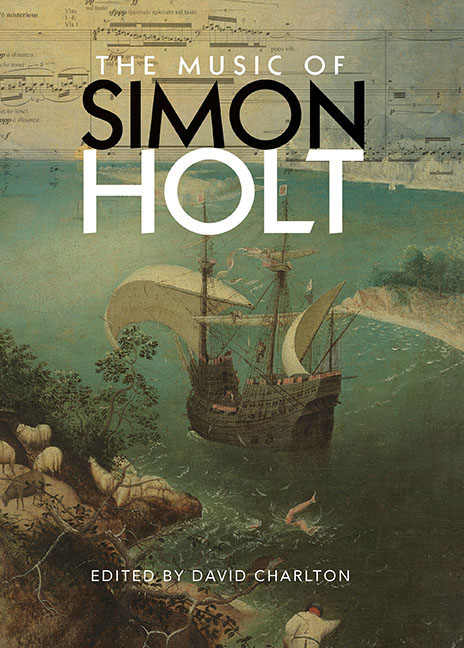Book contents
- Frontmatter
- Contents
- Figures and Tables
- Contributors
- Preface and Acknowledgements
- Abbreviations, with a note on recordings and scores
- Introduction Memories of Magical Moonlight: Simon Holt's years as a composition student
- 1 Duende y Duelos: The Andalusian spirit in the Lorca settings
- 2 An Interplay of Passion and Spirit: The Nightingale's to Blame
- 3 Images in Sound: Movement, harmony and colour in the early music
- 4 Myth and Narrative in 3 for Icarus
- 5 Sound, Sense and Syntax: The Emily Dickinson settings
- 6 Piano Music
- 7 Redefining the Cello's Voice: Musical agency in feet of clay
- 8 Performance and Reflections: Holt's music for oboe and cor anglais
- 9 Shaking the Bars: The Yellow Wallpaper
- 10 Listening to the River's Roar: Stance, texture and space in the concertos
- 11 Orchestral Works in Performance
- 12 Oblique Themes and Still Centres: A conversation between
- 13 Sketching and Idea-Gathering
- 14 Art, Conceptualism and Politics in Holt's music
- Appendix A Overview and Catalogue of Pieces
- Appendix B Texts by Simon Holt for Raju Raghuvanshi is a ghost and The Legend of Melusine
- Bibliography
- Index of pieces by Simon Holt
- General index
7 - Redefining the Cello's Voice: Musical agency in feet of clay
Published online by Cambridge University Press: 01 September 2018
- Frontmatter
- Contents
- Figures and Tables
- Contributors
- Preface and Acknowledgements
- Abbreviations, with a note on recordings and scores
- Introduction Memories of Magical Moonlight: Simon Holt's years as a composition student
- 1 Duende y Duelos: The Andalusian spirit in the Lorca settings
- 2 An Interplay of Passion and Spirit: The Nightingale's to Blame
- 3 Images in Sound: Movement, harmony and colour in the early music
- 4 Myth and Narrative in 3 for Icarus
- 5 Sound, Sense and Syntax: The Emily Dickinson settings
- 6 Piano Music
- 7 Redefining the Cello's Voice: Musical agency in feet of clay
- 8 Performance and Reflections: Holt's music for oboe and cor anglais
- 9 Shaking the Bars: The Yellow Wallpaper
- 10 Listening to the River's Roar: Stance, texture and space in the concertos
- 11 Orchestral Works in Performance
- 12 Oblique Themes and Still Centres: A conversation between
- 13 Sketching and Idea-Gathering
- 14 Art, Conceptualism and Politics in Holt's music
- Appendix A Overview and Catalogue of Pieces
- Appendix B Texts by Simon Holt for Raju Raghuvanshi is a ghost and The Legend of Melusine
- Bibliography
- Index of pieces by Simon Holt
- General index
Summary
Thou, O king, sawest, and behold a great image. This great image, whose brightness was excellent, stood before thee; and the form thereof was terrible. This image's head was of fine gold, his breast and his arms of silver, his belly and his thighs of brass, His legs of iron, his feet part of iron and part of clay.
Daniel 2:31–3 (King James Version)THE SECOND CHAPTER of the Book of Daniel recounts King Nebuchadnezzar's dream of a statue whose head was made of gold, but whose feet were fashioned, in part, of clay. A stone then struck the statue and broke it into pieces, giving rise to the idiomatic phrase ‘feet of clay’, an expression referring to a character-flaw or weakness, particularly in a person of prominence. This somewhat enigmatic idiom provides the title for Simon Holt's feet of clay (H 38) for solo cello, an equally enigmatic piece. Composed in 2003 for Ulrich Heinen, principal cellist with the Birmingham Contemporary Music Group, and premiered the same year at the Huddersfield Contemporary Music Festival, feet of clay's distinctive title is typical of Holt's oeuvre. Among his string output alone we have the sharp end of night, a farewell, Telarañas (cobwebs) and mantis, to name but a few. These are works whose titles invite speculation and encourage certain listening strategies, titles which often invite – even command – agential and narrative enquiry.
feet of clay opens with a declamatory statement, a dramatic cri de coeur (as Holt himself calls it) that draws the listener into an extraordinary sound world in which agency – cued primarily by such vocal allusion – is central to the listening experience (Example 7.1, page 152). The cello's voice forges an instantaneous sense of persona, allowing a subsequent narrative to unfold. The composer's programme note explains that ‘there's a strong sense of the heroic about the piece [which] unfolds like a dramatic scena: a hero returns and tells the tale of how the battle was won. But [Holt asks], was the victory pyrrhic?’
This chapter examines how feet of clay both cues and manipulates a sense of agency through timbral and registral distortions of the cello's voice. Building on theoretical frameworks expounded by Naomi Cumming, Roland Barthes, Robert S. Hatten and Edward Venn, I shall respond to Heinen's recording of the piece, and engage analytically with the score.
- Type
- Chapter
- Information
- The Music of Simon Holt , pp. 145 - 160Publisher: Boydell & BrewerPrint publication year: 2017



